Freedom of movement
We all want to feel free to move. Never as in this precise historical moment, because of the Covid-19 pandemic, can we experience and appreciate the value of this freedom. A freedom that is very often taken for granted but is now magnified as a necessity. “Mobility plays a vital role for the internal market and the quality of life of citizens who enjoy the freedom to travel” says the incipit of the European Union’s White Paper on transport published in 2011, which continues: “Transport is functional to economic and employment growth and must be sustainable in view of the new challenges we face”. The point therefore is to be able to combine the need for mobility – including the personal desire for freedom – with its sustainability. It seems an ambitious challenge: Is it possible to look to the so-called MaaS to address the new paradigm of mobility? Can this MaaS, and the need for sustainability, respond to our desire for freedom of movement?
Digitize supply and demand for mobility
Let’s take a step back. Before talking about MaaS and defining it, it is good to talk about “digitization“. This is a necessary discussion because MaaS lives in a digital world. Of course the traditional concrete and physical experience of transportation continues to live and is critical to the success of implementing MaaS. In fact, a traveler moves within an analog world using means of transport that are analog as well. This is the practice nowadays … teleportation aside!
Digitization of the demand
We now focus on the transport of people, deliberately leaving aside the transport of goods. The logistics of goods is certainly interesting (we often hear about DaaS, Delivery-as-a-Service) and can be intertwined with people transport, but the objective of this article remains the freedom of movement of individuals with a sustainable approach. Having defined this perimeter of action, the demand for mobility is represented by the the demand for mobility is represented by all the subjects who need to make a move. We are seeing to a great degree the new approach to mobility. Individuals in many cases have started their own entry into the digital domain of mobility. This is because the smartphone has reached such a level of usage and dependence. The smartphone is the emblem of the digitization process and has become the preferred way to find information and / or access many mobility services in an area.
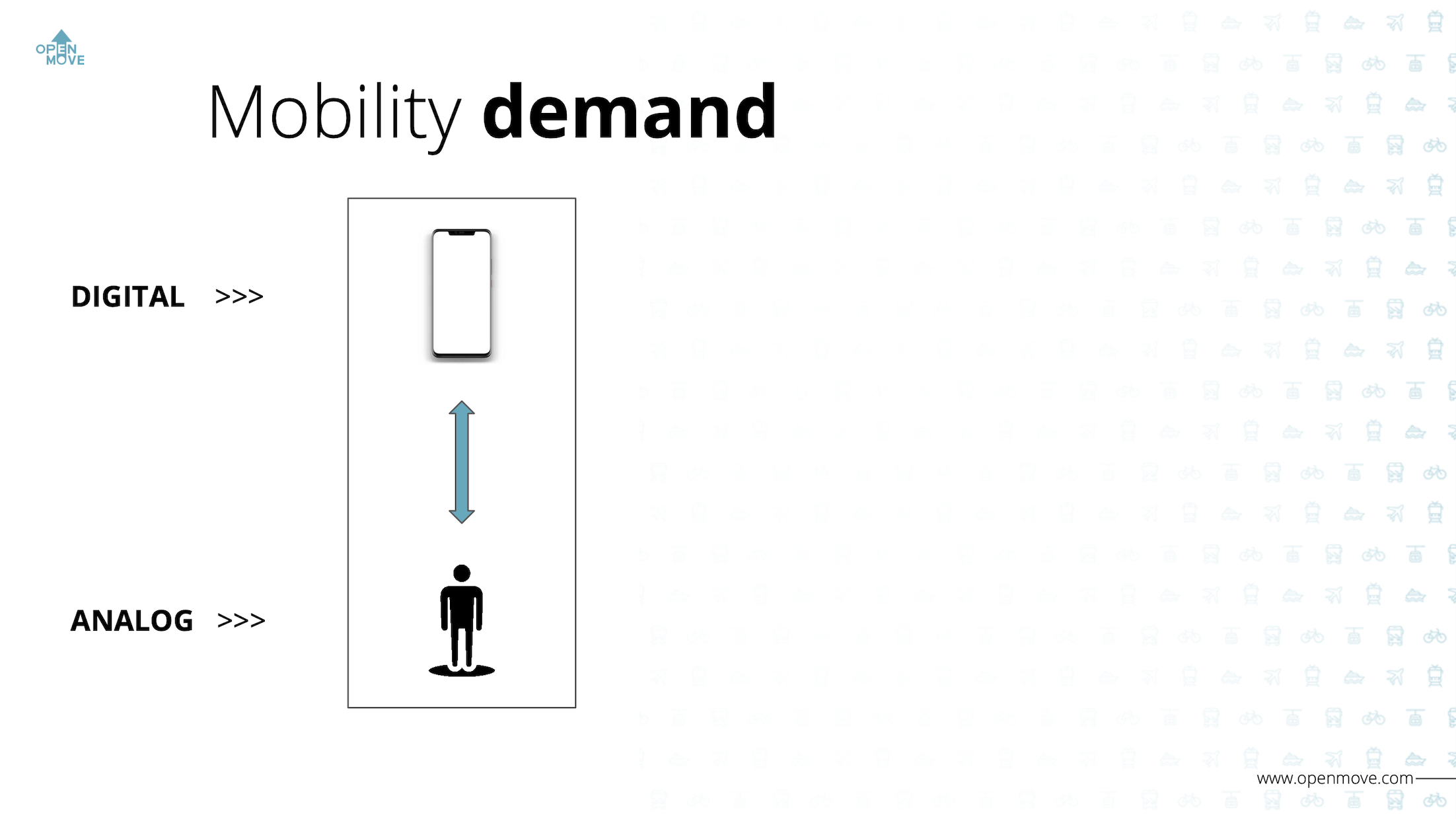
In the image above, the digitization process is represented by the vertical arrow that creates the digital version of an individual, symbolized by the smartphone. We often talk about the Internet of Humans.
Digitization of the offer
The digitization of the offer consists of all the interventions to bring what is intrinsically analog on a digital plane, that is the actual movement of a traveler. ITS systems in many cases perform this task, making information and processes available on a digital domain (for example the GPS position of a bus or the purchase of a travel ticket on the go). As you can see in the image below, the digitization process consists of the vertical arrow that creates a digital counterpart of what is physical, for example a means of transport. For many of these ITS systems it is possible to speak of the Internet of Things.
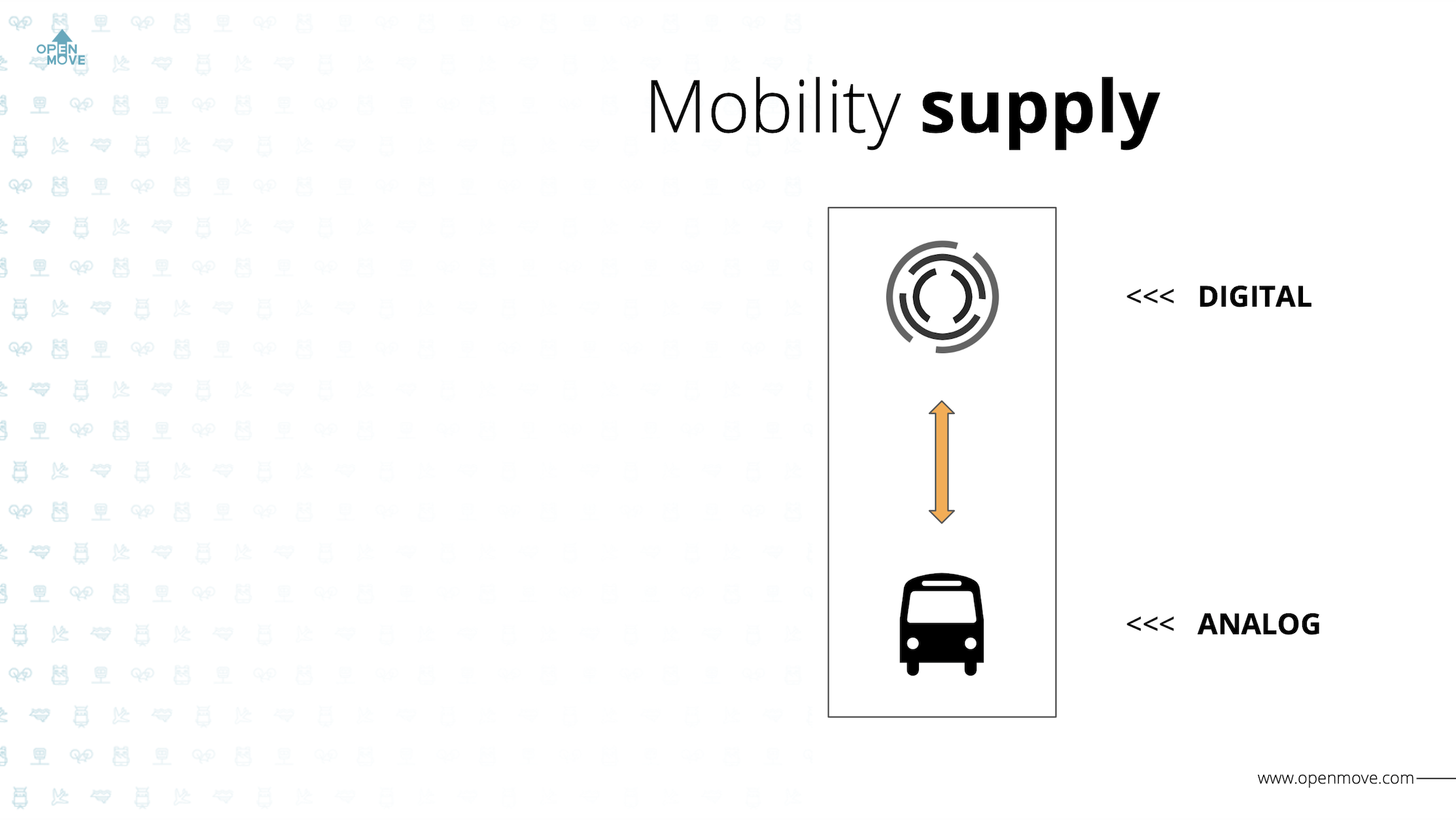
Mobility supply and demand obviously meet on an analogical level: at the present time, however much you dream of teleportation or gift of ubiquity, mobility is necessarily carried out on an analogical level. In other words, the movement we experience is always physical and tangible.
The three arrows
We combine the two diagrams of the digitization of supply and demand. The result is the following image.
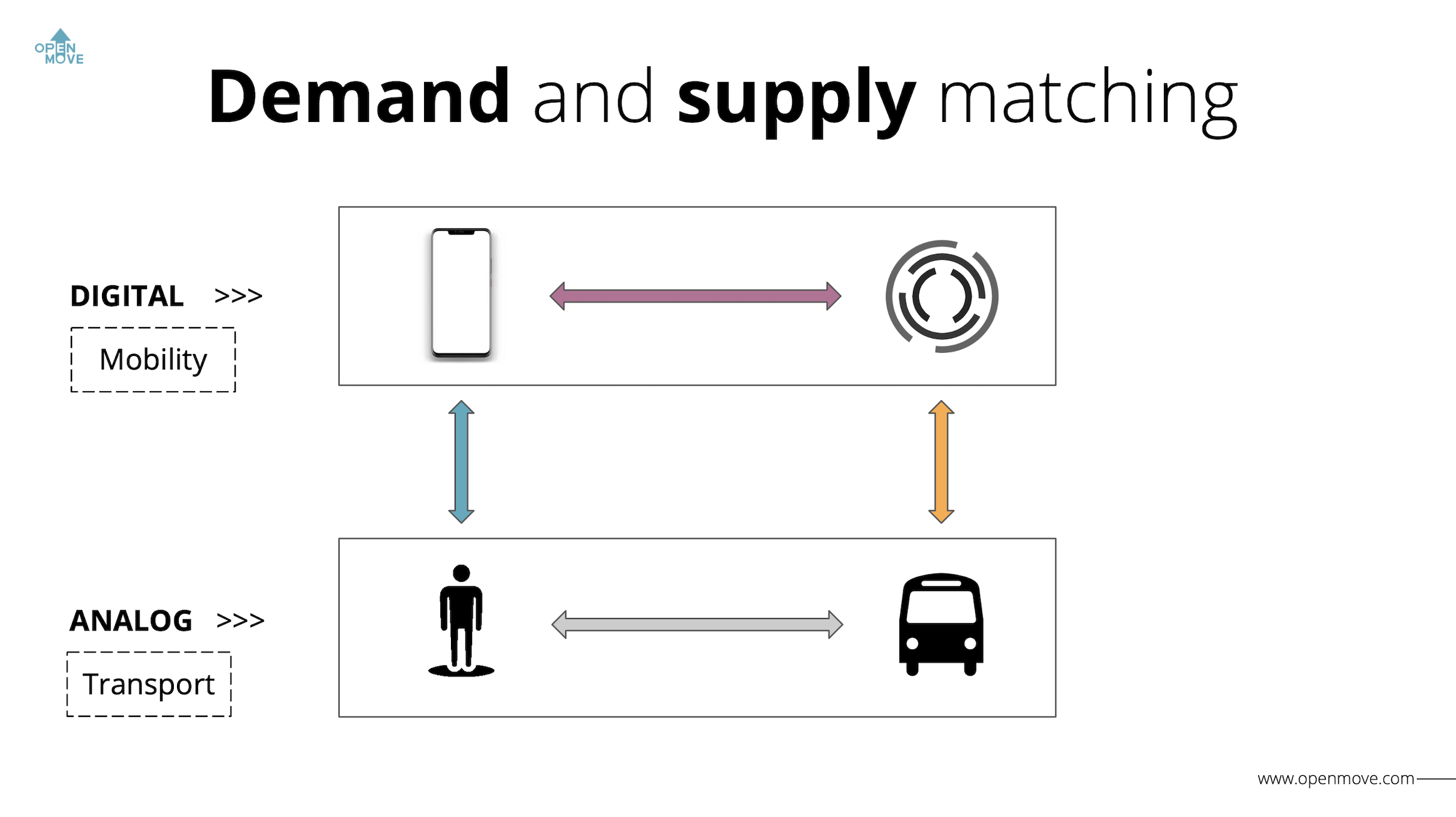
The black boxes highlight two different domains: the analog one at the bottom and the digital one at the top. There is an increasingly marked division between these two worlds, so much so that transport and mobility, two terms that could in many cases be interchangeable, assume, according to this diagram, different meanings: transport represents the material and tangible component of movement, as for example the seat of a train to sit on, the fuel that moves a bus, the pilots of an airplane. Mobility, diametrically opposed, moves away from the analog world and becomes a more abstract and impalpable entity, a precious asset that, given its nature, finds a perfect place in the digital domain. The vertical arrows of the image have been explained previously. The horizontal arrow below describes the purely analogical interaction between supply and demand. Basically, the world of transport when public service timetables were printed in paper booklets, tickets were paper and had to be physically punched by a controller and the only way to get information in real time was to see for yourself a means of transit . Much more interesting nowadays is the horizontal arrow at the top, that is, the one that represents the meeting of supply and demand on a digital level. This is the real theater of the innovation in mobility: many successful inventions or commercial initiatives that have appeared in recent years can be read and analyzed through the outline of the three arrows that we see in the image below.
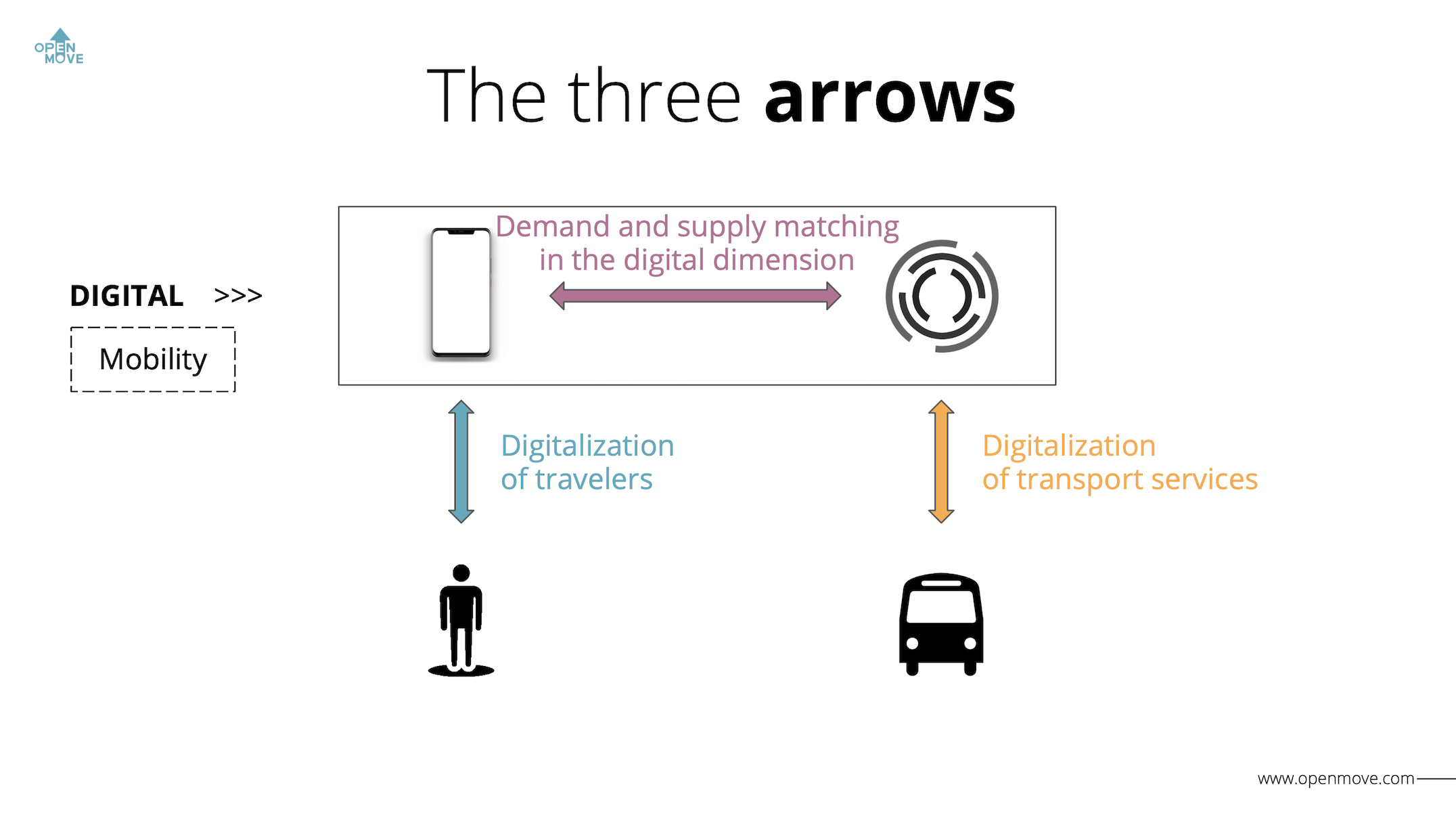
Before going into the merits of the horizontal arrow and its impact as a driver for the business in mobility, it is appropriate to make some important clarifications on the vertical arrows. The digitalization of the demand for mobility could be defined at the state of the art, thanks to the incredible technological progression of user-side tools, the penetration of mobile devices and the performance of mobile networks at increasingly accessible costs. The user is digitized reliably, effectively and at low cost. It is the user himself who provides most of his own digitization (device and connection) and it is sufficient to provide the individual with the software tool necessary to complete this process. In mobility, there are now proven quality apps that exhibit the performance and characteristics needed for successful travel in a digital realm. The digitization of transport services (therefore of the offer for mobility) has historically started before that of demand (for example, fleet management, prior to smartphones), but has grown more slowly and is now lagging behind. It is no coincidence that the technologies present today in the world of Transportation are in many cases obsolete and therefore represent one of the main barriers to innovation in mobility. For example, bars, validators and turnstiles are not only a physical barrier for travelers, but they are also symbolical barriers towards the innovation of mobility. They are and will be at least until it is possible to connect them or employ them as an integral part of a digital domain that is now essential since it is dragged by digital demand. The horizontal arrow at the top is where the magic takes place. This is where new paths open thanks to the exquisite digital meeting of supply and demand. In order to keep this horizontal arrow effective, two robust and good quality vertical arrows are required. The digital meeting is based on the correct and effective digitization of supply and demand. We can say that, on the one hand, it is necessary to provide the appropriate tools to the end user and, on the other hand that precise and reliable data on transport services must be available. Let’s go back to innovations in mobility. Many of these can be read or rethought thanks to the three arrows diagram. Let’s see some examples:
- Flixbus: it acts only and exclusively in the digital dimension, providing an app for users on one hand and digitizing the means of transport on the other (for example: booking, ticketing, AVL, WiFi on board). Transport is provided by thousands of local operators, while Flixbus focuses in particular on digital marketing. The success of Flixbus shows how much the world of transport is unbalanced towards the digital domain, while historically being born or still operating in the analog domain.
- Uber: it is a DRT (Demand Responsive Transport) service that could not even exist without the three arrows: the app for end users (vertical arrow on the mobility demand side), the app for drivers (vertical arrow on the mobility offer side) and the dispatching platform to combine supply and demand on a digital level and, only subsequently, to make it happen in the analog level. The real value of Uber lies in combining the services (horizontal arrow) and this activity relies on the mentioned apps (vertical arrows).
- Micromobility: this phenomenon of the last few years is particularly interesting because it brings the analogical side of transport to the minimum terms, choosing a means of transport that is as contained and economic as possible, and at the same time exploiting the same technologies available for the digitization of the user for the digitization of the scooter (a scooter actually has on board the technology present on a smartphone). Micromobility teaches how it is possible to focus on the digital domain by choosing the smartest way to descend into the analog domain of transport, minimizing expenses and investments. On the other hand, the physical supply of scooters and their maintenance is not the real business of the micro mobility providers … indeed, one could say – probably exaggerating – that it is a necessary evil.
In the second and final part of this article we will see how the three arrow scheme allows us to describe MaaS and finally be able to answer the question: Can MaaS give us a more sustainable freedom of movement than current mobility paradigms?


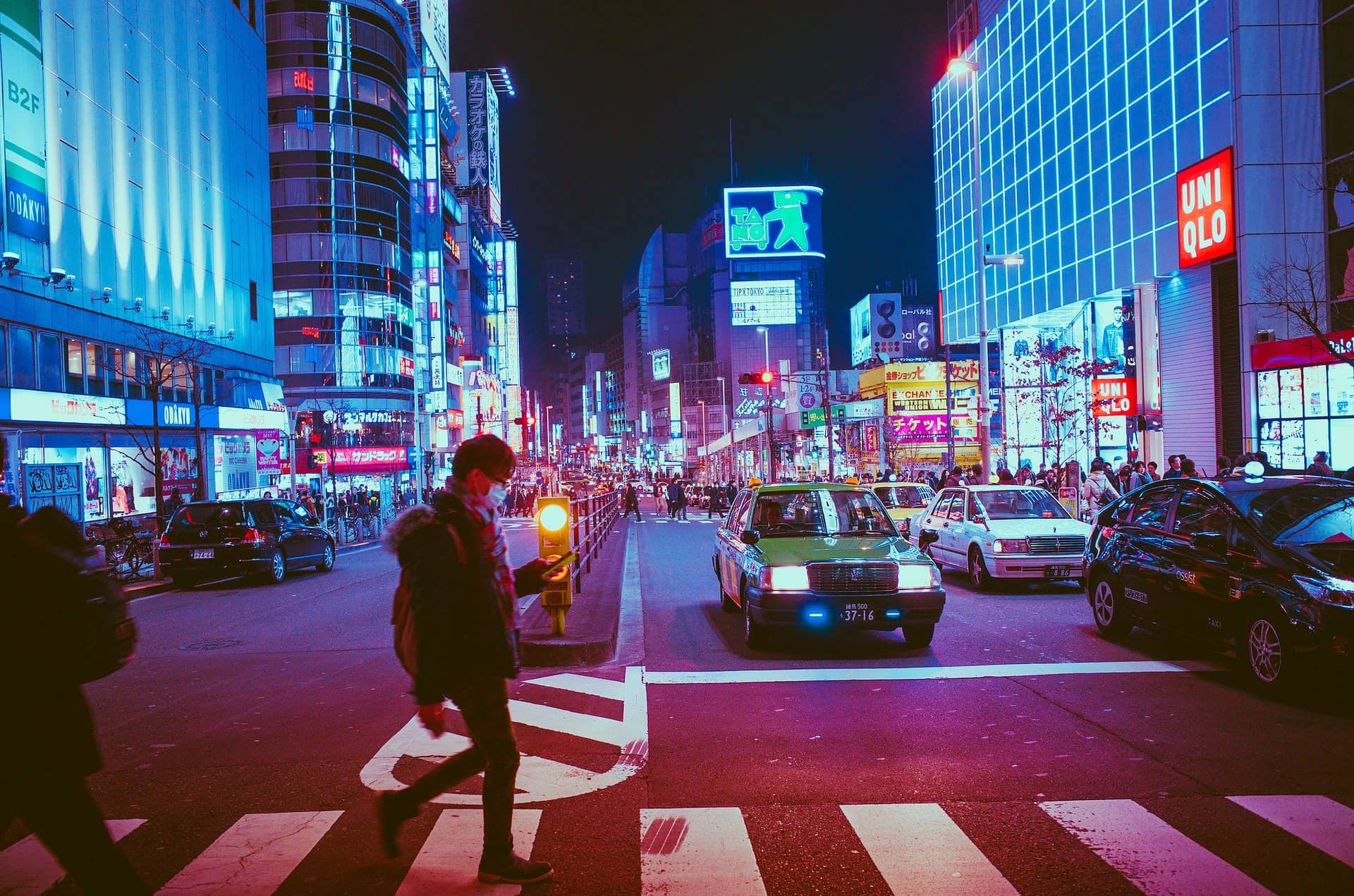
3 Comments